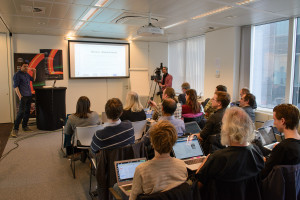Europeana Space Technical Workshop
As part of the Open Knowledge systems administrators team, I was recently invited along to the Europeana Space technical workshop which was held in Brussels at the end of March. Europeana Space aims to increase and enhance the creative industries’ use of online collections of digital cultural content such as Europeana, One of the spaces the project will build is the Technical Space, a framework for storing, accessing and processing cultural heritage content and metadata. The current technical workshop focused on presenting the architecture and implementation choices for the Technical Space, as well as informing participants about the latest developments of Europeana Labs.
After a couple of short plane journeys, I arrived in Brussels on the Sunday evening. The weather was lovely and Brussels is a wonderful city, so after a short stroll I arrived at the iMinds building bright and early on Monday morning keen to find out more about Europeana Space. The first and second talks by Antonella Fresa and James Morley provided us all with a introduction to the project and to the Europeana Labs. Then after a short coffee break we got into the technical part of the day, which was a series of talks by Nasos Drosopoulos on the eSpace technical infrastructure and Remy Gardien on practical experiments using Europeana Labs. The day was then finished with a series of discussions which everyone participated in about potential options for the direction of the Europeana APIs. The second day continued with discussions on how to use and develop the API further.
I found the idea of an API for accessing a large number of digital museum and gallery objects to be a really interesting one. While the Europeana Labs project is still in early stages there is a lot of promise with what has already been done. I’d like to highlight a couple of projects which use the API to show people what’s possible. These two are my personal favourites. Firstly, there is museums.eu, which uses the API in a quite modest way to enhance a site which also uses other data sources. Secondly is VanGoYourself which works on the simple premise of recreating famous paintings with a photograph. It’s a lovely little whimsical website and the photos are great fun to spend a bit of time browsing.
The conference was very enjoyable and I for one look forward to seeing what Europeana Labs and Europeana Space produce in the future. Also it’ll be great to see what use people make of the API.
A full album of photos can be found here on Google plus. All slides and another summary is available here, and you can watch recordings made during the event through this channel.

